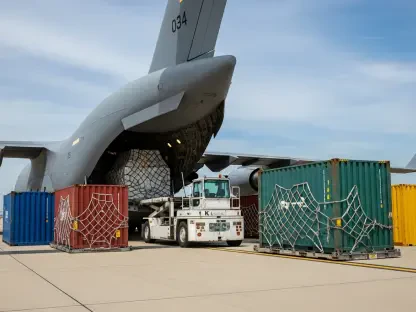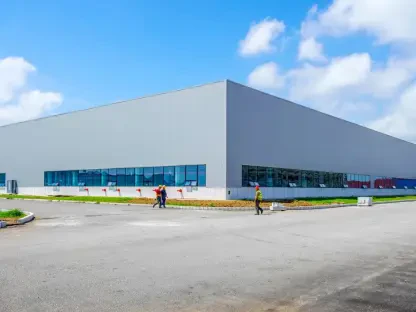Warehouse automation is undergoing a revolutionary shift, largely driven by the innovative solutions provided by PHINXT Robotics. This AI-led robotics software company, founded in 2022 by Yanwen Chen and Quirino Zagarese, has rapidly gained traction within the logistics sector, offering transformative technologies designed to optimize warehouse operations. With a recent £2 million funding boost, PHINXT Robotics is poised to lead the charge in modernizing warehouse automation and setting a new standard in the industry.
Innovation in Warehouse Automation
Edge AI Software Solutions
PHINXT Robotics sets itself apart with its cutting-edge edge AI software solutions. The company’s flagship offering is a cloud-based platform that streamlines the deployment of robots in warehouse settings. This software not only simplifies robotic integration but also addresses two major hurdles: high setup costs and the complexity of deployment. Traditional automation systems often come with prohibitive expenses and intricate installation processes, but PHINXT’s solutions provide a more accessible and efficient alternative. By leveraging advanced algorithms and machine learning, their platform ensures that robots can seamlessly perform tasks without extensive manual input or costly custom configurations.
These edge AI software solutions have gained notable attention for their ability to dynamically adapt to different warehouse environments. The system continuously learns and improves from the data it collects, ensuring that robotic operations become more precise and efficient over time. This adaptability makes it possible for warehouses to integrate automation incrementally, allowing them to see immediate benefits while planning for larger-scale implementations. The cloud-based nature of the software also means that updates and upgrades can be pushed out quickly, ensuring that users always have access to the latest advancements without the need for disruptive downtime.
Decentralized Edge Computing
One of the key technological advancements PHINXT Robotics brings to the table is decentralized edge computing. Rather than relying on a centralized server to control robotic operations, this architecture enables coordination at the edge. This decentralization mitigates the risk of operational disruptions due to connectivity issues, as robots can continue to function autonomously even if the connection to central networks is lost. This innovation not only enhances reliability but also significantly boosts the robustness of robotic systems in warehouses.
The decentralized approach also contributes to the scalability of PHINXT’s solutions. As warehouses grow and operations become more complex, the edge computing model allows for the seamless addition of new robots and functionalities without overburdening a central system. This means that warehouses can scale their automation efforts in a cost-effective and manageable way. Furthermore, the decentralized system aids in maintaining operational security, as sensitive data can be processed locally rather than being transmitted back and forth to a central server, thereby reducing the risk of data breaches.
Flexibility and Cost Efficiency
Subscription-Based Model
PHINXT Robotics offers a flexible subscription-based model that democratizes access to advanced robotics. Traditional automation solutions often involve hefty upfront costs, but PHINXT’s approach allows businesses to subscribe to various robotic services on a monthly basis. This model reduces financial barriers and enables more companies to benefit from automation, fostering broader adoption across an industry where over 90% of warehouses still operate manually. By spreading out the costs over time, businesses of all sizes can take advantage of cutting-edge robotics without the need for substantial initial investments.
The subscription model also provides businesses with the flexibility to scale their use of robotics up or down based on operational needs. This adaptability is critical in a fast-paced logistics environment where demand can fluctuate significantly. By leveraging PHINXT’s model, companies can optimize their costs and only pay for what they use, making advanced automation a viable option for a broader range of warehouses. Additionally, this model promotes continual innovation, as PHINXT can invest in R&D and consistently offer their clients the most advanced robotic capabilities on the market.
Versatility of Robotic Solutions
The company’s adaptable technology supports a range of robots, each tailored to execute specific warehouse tasks from picking to transportation. This versatility ensures that businesses can optimize their operations by selecting the appropriate robotic solutions to meet their unique needs. Early adopters of PHINXT’s technology have reported dramatic improvements in operational efficiency and cost outcomes, with profit margins doubling and productivity increasing up to four times. The tangible benefits observed by these early users underscore the potential for PHINXT’s technology to revolutionize warehouse operations on a broad scale.
The versatile nature of PHINXT’s solutions allows for a modular approach to automation, where different robots can be integrated to handle varied tasks within the same facility. Whether it’s handling delicate picking operations or managing heavy-lifting and transportation duties, PHINXT’s robots can be customized to meet exact functional requirements. This flexibility not only simplifies the integration process but also provides warehouses with the ability to optimize workflows and eliminate bottlenecks. As a result, companies can achieve significant gains in efficiency and throughput, making their operations more competitive and responsive to market demands.
Market Impact and Strategic Growth
Successful Pilot Programs
PHINXT Robotics has demonstrated its practical efficacy through successful pilot programs. One notable example includes their partnership with a major UK grocery retailer. These pilot programs not only validate the effectiveness of PHINXT’s solutions but also lay the groundwork for future expansion. The positive outcomes from these pilots have led to significant contracts and long-term business relationships, setting the stage for sustained growth in a competitive market landscape. These partnerships also provide valuable feedback that helps PHINXT refine and enhance their offerings, ensuring that their solutions remain at the forefront of industry needs.
Pilot programs have proven crucial in illustrating the real-world advantages of PHINXT’s technology, offering a detailed glimpse into how their robotics can handle complex, large-scale warehouse environments. The success stories from these initial deployments serve as powerful testimonials that can attract more businesses looking to automate their operations. Moreover, these pilot programs help in building a robust business case for automation investments, showcasing the potential return on investment and reducing the perceived risks associated with adopting new technologies. This strategic approach has been instrumental in helping PHINXT secure high-profile contracts and establish a strong market presence.
Strategic Market Positioning
The recent £2 million funding round, led by prominent investors such as Sure Valley Ventures and Ada Ventures, underscores the strong market confidence in PHINXT Robotics’ potential. This capital injection will be used to scale the company’s operations, including expanding their engineering and sales teams, and initiating market entry across Europe. The backing from investors specializing in AI and robotics highlights the broad consensus regarding the high impact and scalability of PHINXT’s innovative solutions. This financial boost provides the necessary resources to accelerate the company’s growth trajectory and enhance their technological offerings.
The strategic market positioning of PHINXT is further reinforced by its ability to attract and retain top talent in the robotics and AI fields. By leveraging the expertise of a highly skilled workforce and the financial support from leading investors, PHINXT is well-equipped to drive continuous innovation. This solid foundation enables the company to respond swiftly to market trends and customer needs, ensuring that their solutions remain relevant and effective. The combination of strategic investments and a clear vision for future growth positions PHINXT Robotics as a key player in the ongoing transformation of the logistics industry.
Long-term Vision and Expanded Applications
Broader Technological Horizons
While PHINXT Robotics has made significant strides in warehouse automation, their vision extends beyond this sector. The company aims to revolutionize various aspects of logistics and transportation, including deploying delivery drones and developing autonomous vehicles. This broader focus indicates a comprehensive strategy to integrate advanced robotics and AI across multiple facets of logistics, thereby driving efficiency and innovation. By exploring diverse applications of their technology, PHINXT positions itself to capitalize on emerging trends and expand its market reach.
Innovations in delivery drones and autonomous vehicles have the potential to transform supply chain and logistics operations on a global scale. With the ability to handle last-mile deliveries and long-haul transportation autonomously, PHINXT’s technology could significantly reduce operational costs and delivery times. This expansion into new areas not only demonstrates the versatility of their AI and robotics solutions but also their commitment to pushing the boundaries of what is possible in logistics. By investing in these forward-looking technologies, PHINXT ensures that they remain at the cutting edge of industry advancements and maintain a competitive edge.
Transformative Leadership
The founders, Yanwen Chen and Quirino Zagarese, leverage their extensive expertise in robotics and distributed systems to guide PHINXT’s technological advancements. Their leadership ensures that PHINXT’s solutions are not only cutting-edge but also practical and resilient. The sophisticated algorithms developed by their team are designed to ensure operational reliability, even in scenarios where connectivity with central networks is disrupted. This blend of visionary leadership and technical prowess propels PHINXT to the forefront of warehouse automation innovators.
Chen and Zagarese’s vision for PHINXT goes beyond immediate technological advancements; they aim to cultivate a culture of continuous innovation and problem-solving. By fostering an environment where creativity and collaboration thrive, they empower their teams to push the envelope and develop pioneering solutions that address the most pressing challenges in logistics. This transformative leadership approach has been a critical factor in attracting top talent and securing crucial investments, further solidifying PHINXT’s position as a leader in warehouse automation. Under their guidance, PHINXT is set to continue making significant strides in the industry, positively impacting a wide range of logistics and transportation applications.
Conclusion
Warehouse automation is experiencing a revolutionary transformation, significantly driven by the innovative solutions from PHINXT Robotics. Founded in 2022 by Yanwen Chen and Quirino Zagarese, this forward-thinking AI-led robotics software company has swiftly made its mark in the logistics sector. By offering cutting-edge technologies, PHINXT Robotics aims to streamline and optimize warehouse operations, making them more efficient and effective.
With a recent infusion of £2 million in funding, the company is well-positioned to spearhead modernization in warehouse automation. This financial boost not only reinforces their growth but also underpins their commitment to setting new benchmarks in the industry. This venture from PHINXT Robotics is expected to have far-reaching impacts, transforming not just individual warehouses but the logistical landscape as a whole. Their rapid ascent and the anticipated advancements are setting a new standard, reflecting the crucial role of AI and robotics in shaping the future of supply chain management and operational efficiency.









